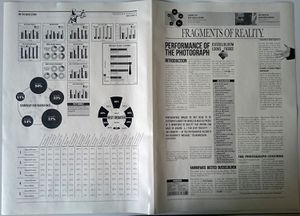User:Ruben/TP2/Fragments of Reality
Fragments of Reality
“A picture is worth a thousand words.” This proverb exposes how in our society we look at images, and how a sense of truthfulness is ascribed to them. As Susan Sontag elaborates, this accounts for photographic images in particular. They are seen not as subjective statements about the world, rather as pieces of it – as fragments of a reality. Often images are seen as unbiased. They carry in them the ‘burden of truth’. We use them to give meaning, to asses and to judge. But if we see an event as the cumulative of subjective experiences. Than inherently an image is always lacking in its representation.
Photographed images do not seem to be statements about the world so much as pieces of it, miniatures of reality that anyone can make or acquire. [...] This very passivity —and ubiquity— of the photographic record is photography’s “message,” its aggression.
Susan Sontag, On Photography
Starting point for this project was Joris Luyendijk's book Het zijn net mensen (2006 - People like us 2009), in which he elaborates how a photograph can be seductive. It presents an event, rather than representing it. By selectively showing images an 'image' of an event is constructed. Though seemingly subtle, it is very persuasive.
Fragments of Reality is a paper that assembles descriptions of five images of one event: a press conference with Jeroen Dijsselbloem and Yanis Varoufakis. Each interviewee was shown one of the images, in attempt to highlight how we read events trough photographs.
The press conference as a form is particularly interesting for this project as it is a pseudo-event: it is staged to be mediated; to be photographed. It is an orchestrated presentation, yet the power relations between the two man seem to vary with each photograph.
As an interviewee explains in his final remarks, one often approaches an image from his own understanding - from his own context. Rather than that the images helps to revise his opinion, his opinion steers his interpretation of the fragment. This underlines the need for context in photographic presentation.
The irony in the project lies in the fact that I, as a maker, cannot escape the same fate as the newspaper editor who picks the photographs. Just as a documentary film maker never can be fully objective. When I make a selection of images, curate and juxtaposed their descriptions and present the 'statistics' [1] in designed graphs, I steer the interpretation of these interpretations.
This reminded me of a conversation we when working on the ideology project with Steve. We were discussing the film Episode III: Enjoy Poverty (2008, Renzo Martens) and how it attempts to reveal certain ideologies:
Steve: Renzo finds a mechanisms to reveal the ideologies. For example the 'Doctors without Frontiers'.
Julie: But Renzo is actually acting in the same way, he is funded in the same way.. he is promoting himself in the same way..
Steve: That seems to be the limits of art as a critique...
So rather than rejecting this steering of interpretation, embrace it. Fragments of Reality is not an attempt to represent these images and their interpretations. Rather I try to recontextualise them. In an attempt to grab this phenomenon from its invisibility and render it visible.
- ↑ The 'statistics', with a set of 35 interviewees, make no attempt to be statistically significant. As this was out of the scope of this project.


